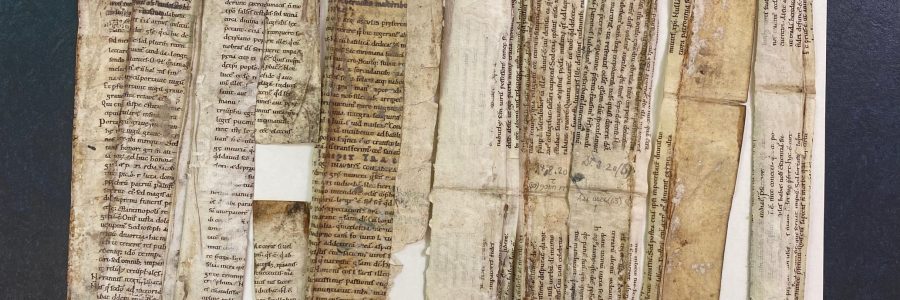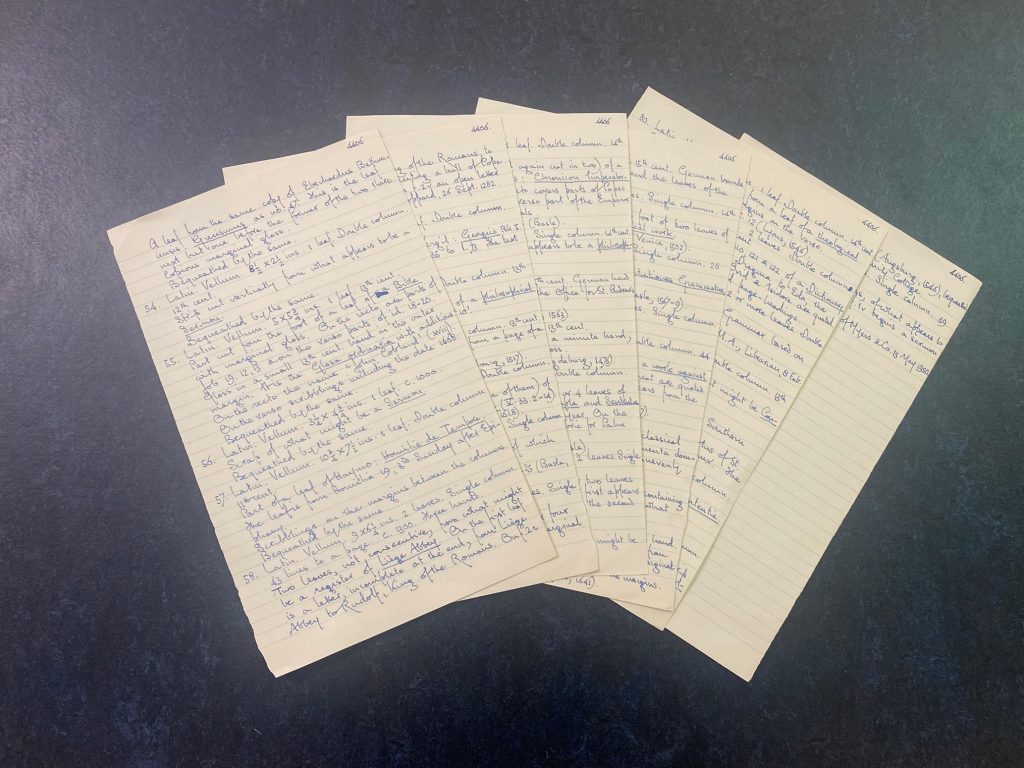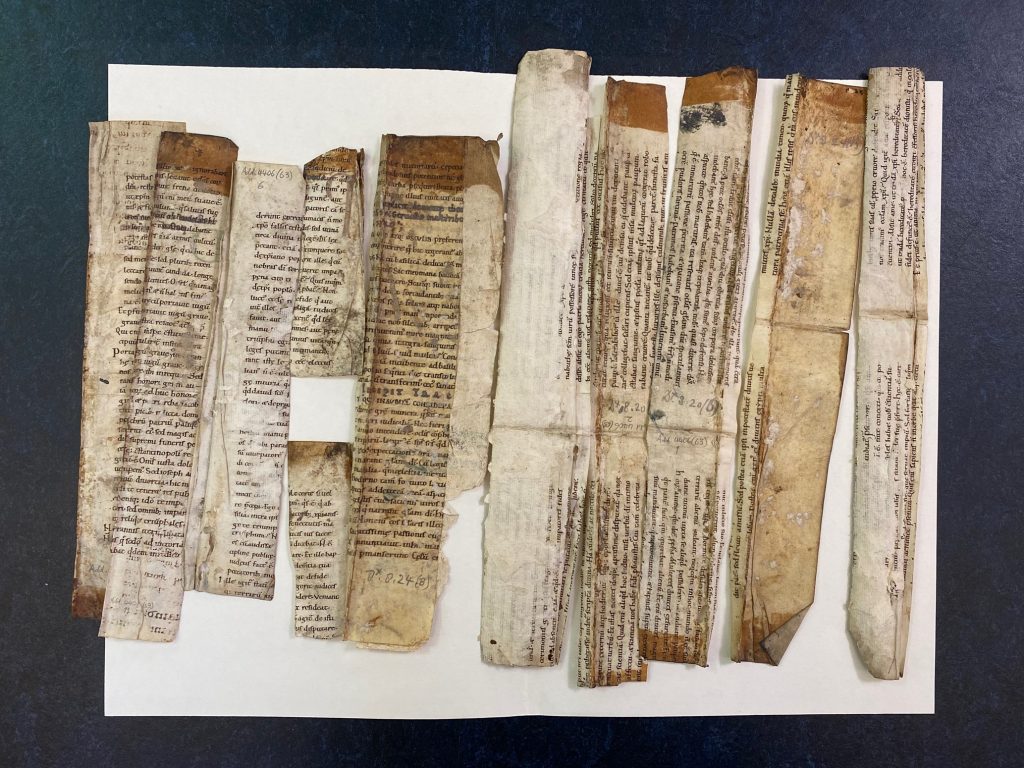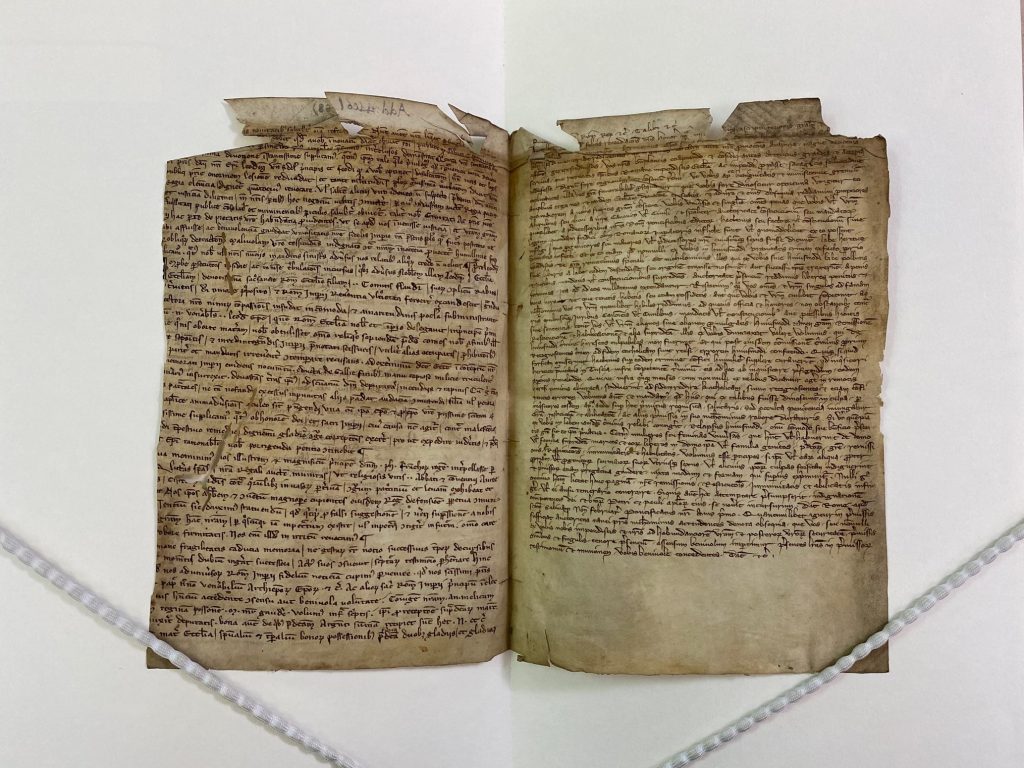
Fragments, fragments, fragments
A guest post by Matthew Coulter
In libraries across the world there are boxes and boxes of fragments from medieval texts. Between the 15th and 17th centuries it was common practice among bookbinders to cut up older medieval books so that the parchment leaves could be used to hold together the bindings of their newer printed books (more about that here). Then, in the 19th and 20th centuries it became common practice among libraries to remove books from the constraints of their original early modern bindings and to give them shiny new modern bindings, thus liberating the parchment held within. A growing awareness of the potential research value of these largely uncatalogued fragments has resulted in numerous projects among special collections libraries to produce systematic online databases of these sources, many of these related to the Fragmentarium digital library.
Medieval fragments were much on my mind last term, since with the support of my doctoral funding body (the AHRC OOC DTP) I undertook a 10-week placement at Cambridge University Library to produce catalogue entries for fragments which will eventually accompany their digitized images on the Cambridge Digital Library (CUDL, adorably pronounced ‘cuddle’). I therefore wanted to offer some fragmentary reflections on working on this project, and hopefully convince you that cataloguing manuscripts is fun!
I was drawn to this project because over the course of my PhD I have come to realize that working with archives and manuscripts is the aspect of my work which I enjoy the most, leading me to consider a career in archiving. I especially enjoy the investigative work and the ability to apply my skills in palaeography beyond my own research area (medieval Transylvania), but I was also drawn to the opportunity to see behind the scenes in a working archive and to contribute to an exciting multinational cataloguing project. On the first day of the placement, I received training from the project cataloguer, Dr Marie Turner, on using the TEI-XML (in Oxygen) to encode catalogue entries. The TEI (Text Encoding Initiative) is designed by a consortium which seeks to standardize the way that we render texts in digital form using the language XML (Extended Markup Language).
Though my background as a medieval historian means that I have certainly worked with and written about manuscripts before, cataloguing required me to ask quite different questions of the manuscripts which I come across to those which I would as a researcher. As a doctoral student looking for a specific text or type of source it can be easy to ignore other aspects of the sources in question, whereas as a cataloguer it is important to make the entry as prescriptive, systematic, and accessible as possible. This meant including in the entry all of the features which might be of interest to someone consulting CUDL; aside from a text’s palaeographic features, this might be the way in which a manuscript or text has been decorated, whether there are marginal annotations present, the presence of musical notation, and so on. The XML template was hugely helpful here, and increases the accessibility and searchability of the catalogue by requiring machine-readable codes alongside the human-readable text entries.
When opening a new box or folder I never quite knew what I was going to get, and the challenges of working with a text on which I have very little prior information is something which I find highly enjoyable (if at times frustrating). For the first folder I catalogued I was able to use the notes of former University librarian Basil Atkinson, whose ability to identify texts was very impressive in an age before the Corpus Corporum.

However, Atkinson’s notes were (understandably) sometimes vague or inaccurate, and so it was still necessary to check whether his identifications were correct. In one instance I opened a folder to find 11 strips which had been cut from a single manuscript and used in the bindings of 5 different books. They were not from a legendarium text as Atkinson thought, but rather a compilation of texts by St Ambrose of Milan (d. 397) containing at least 7 texts. Trying to work out which text was which did at first seem a gargantuan task, but being able to catalogue these texts properly is simultaneously quite satisfying. For the last folder in the box there was no pre-existing catalogue on which to rely, meaning that I had to trust my instincts (or ask Marie if I was really stuck).

Though many (most) of the fragments I came across were from large patristic tomes or legal compilations, the range of different texts which ended up stuffed into early modern bindings is pretty impressive. I personally have an affinity for the scrappier manuscripts which always have the potential to be overlooked. Among my favourites are a bifolium (two leaves) containing a late thirteenth-century letter collection from Germany (thirteenth-century letter collections from Germany are sort of my thing, so this was quite a find), and a single rather sorry-looking leaf containing brief biographies/obituaries of various sixteenth-century figures connected to St Cuthbert’s Priory in Durham, among them Cardinal Thomas Wolsey, which will be the subject of a future blogpost.

There is no doubt that this experience made me more attentive to the manuscripts which I come across. With Marie’s guidance I also became marginally more effective at identifying and dating different types of medieval handwriting based on their specific features (though as Albert Derolez says, this is something that can never truly be taught).[1] The Fragmentarium project is also running alongside the UL’s Curious Cures cataloguing project (who have their own blogposts), and so it was wonderful to work in a team of people who are all passionate about increasing the visibility and availability of medieval manuscripts. This means that there is usually someone around who can help with any issues which might crop up, be they palaeographical or technological.
Matthew Coulter, PhD student, Faculty of History
[1] Albert Derolez, The Palaeography of Gothic Manuscript Books: From the Twelfth to the Early Sixteenth Century (Cambridge: Cambridge University Press, 2003), 1.

I love to read that again someone falls in love with fragments. Welcome to the group!
But… “Between the 15th and 17th centuries it was common practice among bookbinders to cut up older medieval books”. Nope! Since the codex exist, there are reused texts in it. One of the earliest bindings has reused papyri.
And in many 9th till 14th c bindings you find parchment pages. Maybe something to consider?